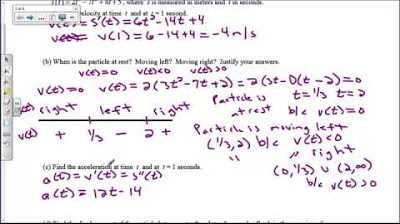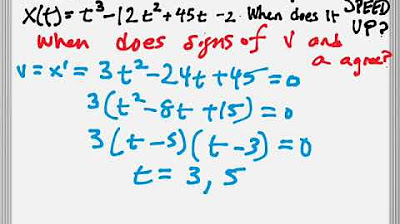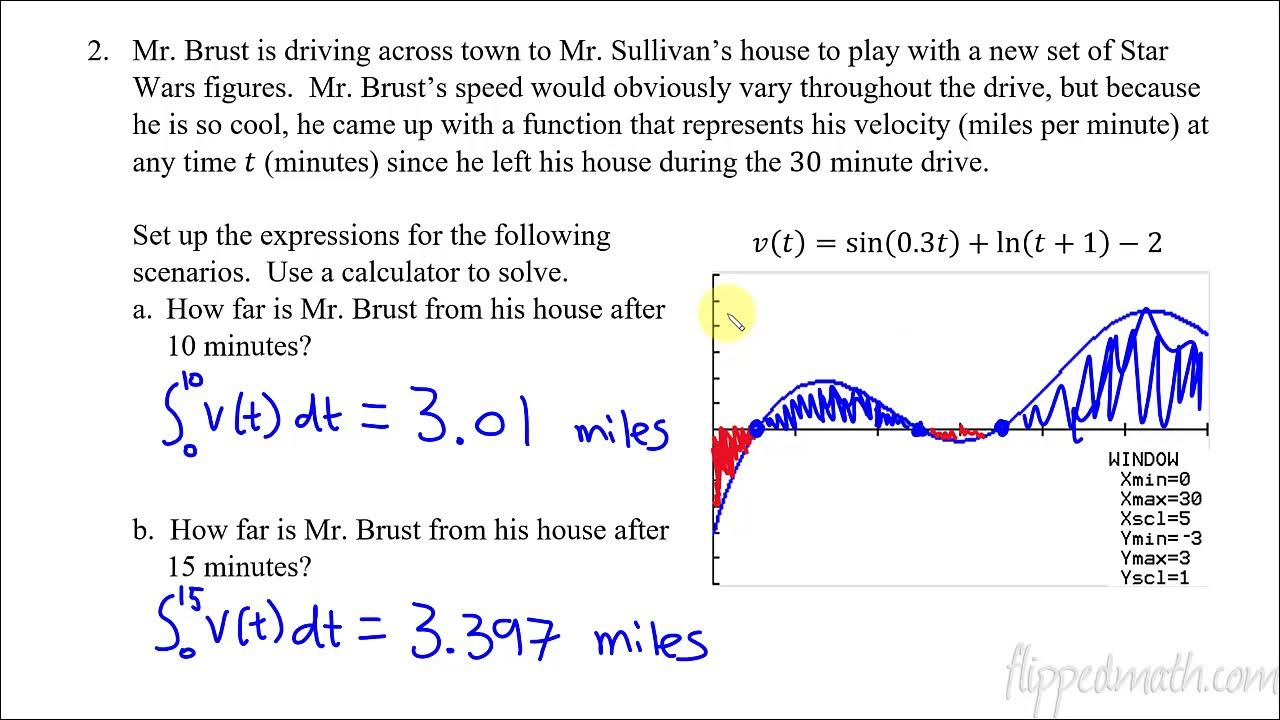Use Position Function to Determine the Vel and Acc Funct and When Object is Speeding Up or Slowing
TLDRThis educational script explains the process of deriving a particle's velocity and acceleration functions from its position function, given as a cubic equation in meters over time in seconds. It demonstrates how to find when the particle slows down by analyzing the signs of velocity and acceleration across different time intervals. The script involves solving quadratic equations, plotting number lines, and identifying intervals where the particle's speed decreases due to opposite signs between velocity and acceleration.
Takeaways
- 📚 The script is a tutorial on finding the velocity and acceleration functions from a given position function of a particle.
- 🔍 The position function is given as \( s(t) = 3t^3 - 36t^2 + 63t + 16 \) meters, where \( t \) is time in seconds.
- 📝 Velocity is the first derivative of the position function, resulting in \( v(t) = 9t^2 - 72t + 63 \).
- 🔎 The acceleration function is the second derivative of the position function, calculated as \( a(t) = 18t - 72 \).
- 🔑 To determine intervals of slowing down, the script suggests comparing the signs of velocity and acceleration.
- 🧩 The velocity function equals zero at \( t = 1 \) and \( t = 7 \), found by factoring and solving the quadratic equation.
- 📉 The acceleration function equals zero at \( t = 4 \), by solving the linear equation \( 18t - 72 = 0 \).
- 📌 The script uses number lines to determine the signs of velocity and acceleration in different intervals.
- 🔴 The particle slows down when the velocity and acceleration have opposite signs, specifically between \( t = 0 \) to \( t = 1 \) and \( t = 4 \) to \( t = 7 \).
- 🟢 The particle speeds up when the velocity and acceleration have the same sign, which occurs outside the intervals mentioned above.
- 📈 The tutorial provides a step-by-step method to analyze the motion of a particle using calculus, emphasizing the importance of sign analysis for determining the direction of motion.
Q & A
What is the given position function s(t) for the particle?
-The position function s(t) is given as 3t^3 - 36t^2 + 63t + 16, where t is in seconds and s(t) is in meters.
How is the velocity function v(t) derived from the position function?
-The velocity function v(t) is derived by taking the derivative of the position function s(t) with respect to t, resulting in 9t^2 - 72t + 63.
What is the acceleration function a(t) and how is it found?
-The acceleration function a(t) is the derivative of the velocity function v(t), which is found by differentiating 9t^2 - 72t + 63 with respect to t, yielding 18t - 72.
How can we determine the intervals where the particle is slowing down?
-The particle is slowing down in intervals where the velocity and acceleration have different signs. This is determined by finding where both functions equal zero and then analyzing their signs in the intervals between these points.
What is the equation for when the velocity function v(t) equals zero?
-The equation for when v(t) equals zero is 9t^2 - 72t + 63 = 0, which can be factored to 9(t - 7)(t - 1) = 0.
What are the critical points for the velocity function v(t)?
-The critical points for the velocity function v(t) are t = 1 and t = 7, where the function equals zero.
How can we determine the intervals of positive and negative velocity?
-By testing values in the intervals (0, 1), (1, 4), and (4, 7), we can determine that the velocity is positive when t < 1, negative when 1 < t < 4, and positive again when t > 7.
What is the equation for when the acceleration function a(t) equals zero?
-The equation for when a(t) equals zero is 18t - 72 = 0, which simplifies to t = 4.
What is the critical point for the acceleration function a(t)?
-The critical point for the acceleration function a(t) is t = 4, where the function equals zero.
How can we determine the intervals of positive and negative acceleration?
-By testing values to the left and right of t = 4, we find that the acceleration is negative when t < 4 and positive when t > 4.
What are the open intervals where the particle is slowing down according to the script?
-The particle is slowing down over the open intervals (0, 1) and (4, 7), where the velocity and acceleration have different signs.
Outlines
📚 Calculating Velocity and Acceleration Functions
This paragraph introduces the mathematical process of finding the velocity and acceleration functions of a particle given its position function. The position function is defined as \( s(t) = 3t^3 - 36t^2 + 63t + 16 \) meters, where \( t \) is time in seconds. The velocity function \( v(t) \) is derived by taking the derivative of the position function, resulting in \( v(t) = 9t^2 - 72t + 63 \). Further, the acceleration function \( a(t) \) is found by differentiating the velocity function, yielding \( a(t) = 18t - 72 \). The paragraph discusses the steps involved in these derivations, including the application of the power rule and the process of factoring to solve for when the velocity is zero.
🔍 Determining Intervals of Deceleration
This paragraph focuses on determining the intervals during which the particle is slowing down. The slowing down occurs when the velocity and acceleration have opposite signs. The solution begins by finding the roots of the velocity function, which are \( t = 1 \) and \( t = 7 \), and then testing the sign of the velocity function in the intervals defined by these roots. The acceleration function is also analyzed by finding its zero at \( t = 4 \) and testing its sign in the intervals around this value. The paragraph concludes by identifying the open intervals where the particle is slowing down: from \( t = 0 \) to \( t = 1 \) and from \( t = 4 \) to \( t = 7 \). The explanation includes the use of number lines to visualize the signs of the velocity and acceleration functions and the implications of these signs on the particle's motion.
Mindmap
Keywords
💡Position function
💡Velocity function
💡Acceleration function
💡Derivative
💡Polynomial
💡Factoring
💡Intervals
💡Zero of a function
💡Sign analysis
💡Slowing down
Highlights
The position function of a particle is given by s(t), where t is in seconds and s(t) is in meters.
Velocity function v(t) is derived from the position function s(t).
The derivative of s(t) = 3t^3 - 36t^2 + 63t + 16 is calculated to find v(t).
The velocity function v(t) is found to be 9t^2 - 72t + 63.
Acceleration function a(t) is the derivative of the velocity function v(t).
The acceleration function a(t) is calculated to be 18t - 72.
The particle slows down when velocity and acceleration have different signs.
The equation 9t^2 - 72t + 63 = 0 is solved to find when velocity is zero.
The velocity function is factored to find t = 1 and t = 7 as critical points.
The velocity function is positive when t < 1 and negative when t > 1.
The acceleration function a(t) is zero when t = 4.
The acceleration function is negative for t < 4 and positive for t > 4.
The particle is slowing down over the open interval from 0 to 1.
The particle is speeding up over the open interval from 1 to 4.
The particle is slowing down again over the open interval from 4 to 7.
The particle is speeding up over the open interval from 7 to infinity.
The intervals where the particle is slowing down are (0, 1) and (4, 7).
Transcripts
Browse More Related Video

Particle MotionDay1

when does a particle speed up or slow down?

2008 AP Calculus AB Free Response #4

Motion problems: when a particle is speeding up | AP Calculus AB | Khan Academy

Slowing Down Speeding Up Derivatives Application Calculus MCV4U

Calculus AB/BC – 8.2 Connecting Position, Velocity, and Acceleration of Functions Using Integrals
5.0 / 5 (0 votes)
Thanks for rating: